Rock and Roll
One bright fall morning, I notice that the noise level at Under the Gingko Tree is exceptionally low. A quick glance around reassures me that all of my early learners are safe and accounted for. Then I notice a quiet but intense play buzz happening in our rain garden, so I wander over to see what has captured the children’s unwavering attention for so long.
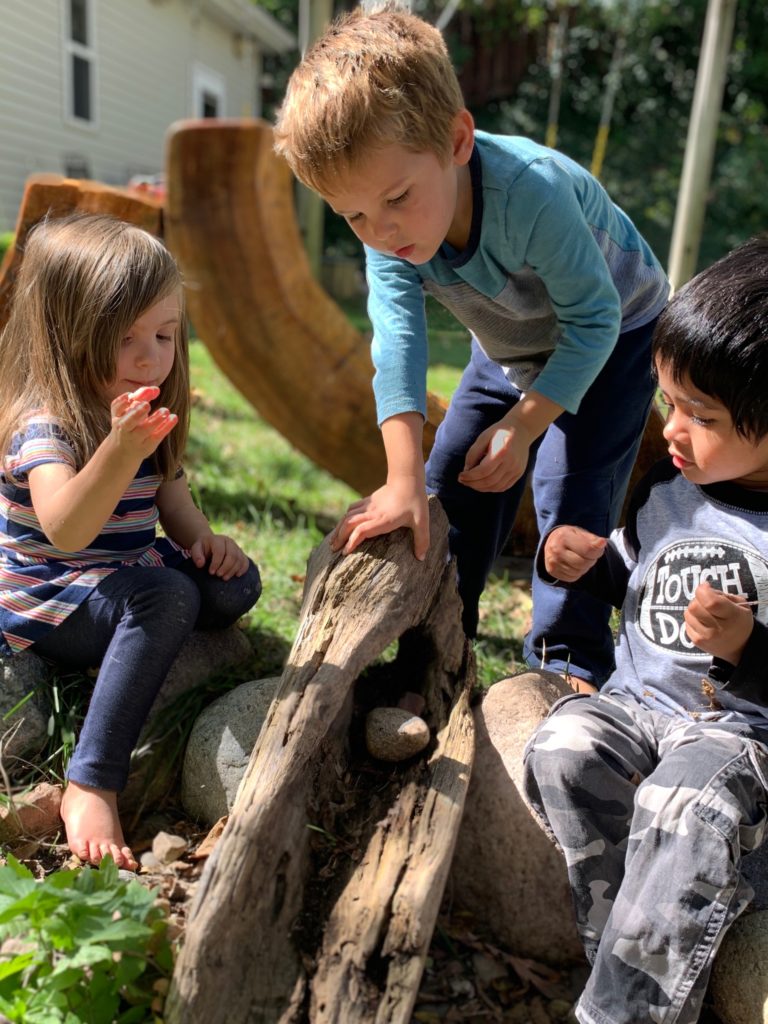
“See? We are using the log to make our hill!” Jameson explains to me.
“We are rolling the rocks down the hill, but our hill has a tunnel!” giggles Noa.
“They go in and then they roll down!” two-year-old Tariq tells me, trying to keep pace with his older friends.
“This rock is flat on this side. It won’t roll, just like Ricky!” Jameson reminds me.
The rocks in the rain garden and a hollow log have triggered an idea from another one of our favorite books: Ricky, the Rock That Couldn’t Roll.
Ricky is a flat rock that can’t roll with his friends on their favorite hill. Ricky’s friends help him overcome his challenge and find a way for Ricky to play like everyone else.
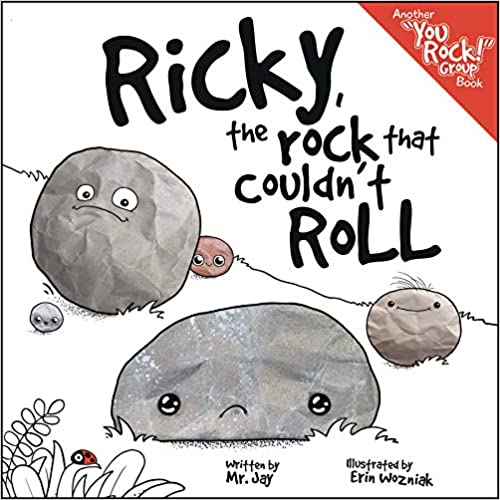
Suddenly we have piles of rocks that have the same names and characteristics as the rocks in the book. I love it when an idea takes hold and inspires creativity and collaboration as the children begin to plan an activity on their own.
We have a STEM morning unfolding in our outdoor classroom! When the children start using words like “in,” “down,” “over,” “under” and “next to,” they are laying the foundation for geometry. Oh, this is going to be a fun morning!
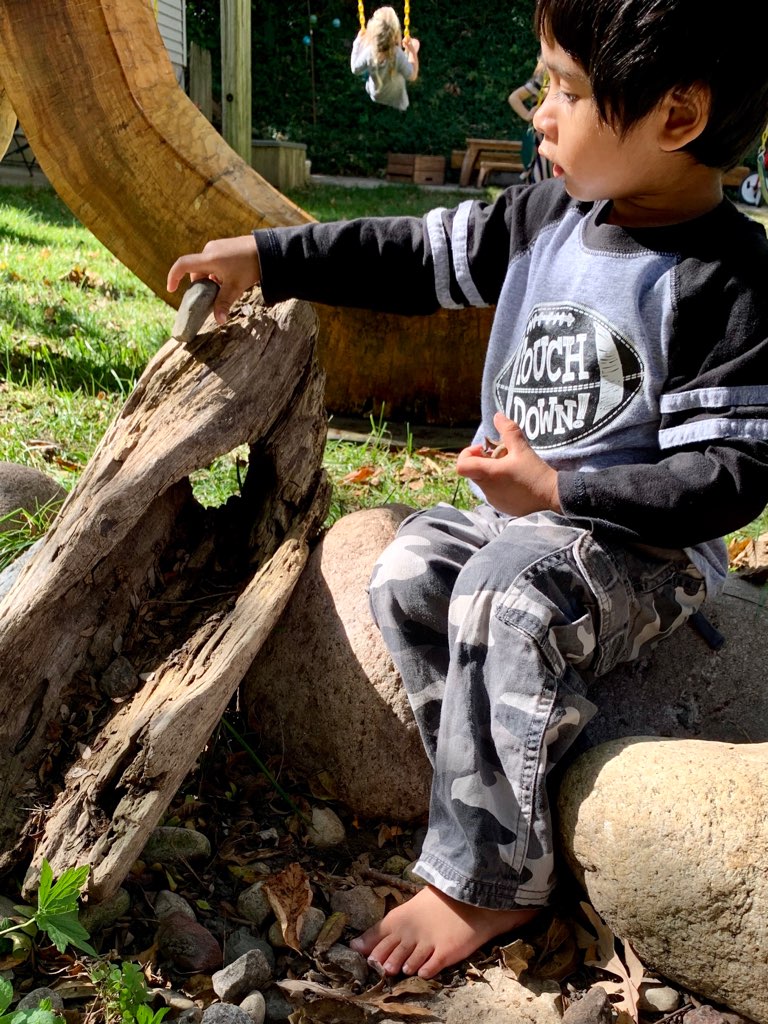
As I watch the children design and develop models that represent their ideas, I think to myself, “This is what early math and science learning looks like.” Planning and carrying out simple investigations like this one will make your assessment nightmare seem like a dream. Math and science overlap so much in this morning’s quest for understanding. This is the kind of play that hones children’s problem-solving skills and enables them to meet important early learning milestones.
I see the young friends sorting and classifying piles of rocks—grouping the flat rocks together and then creating another classification for the rocks that will fit into the tunnel. I observe and listen as they demonstrate their comprehension of the sorting and classifying process by comparing and sharing descriptions. When children use words such as “short,” “wide,” “heavy” and “light,” they are using descriptors for measurement. When they are guessing, predicting, classifying and putting rocks in a specific order, they are engaging in early algebra.
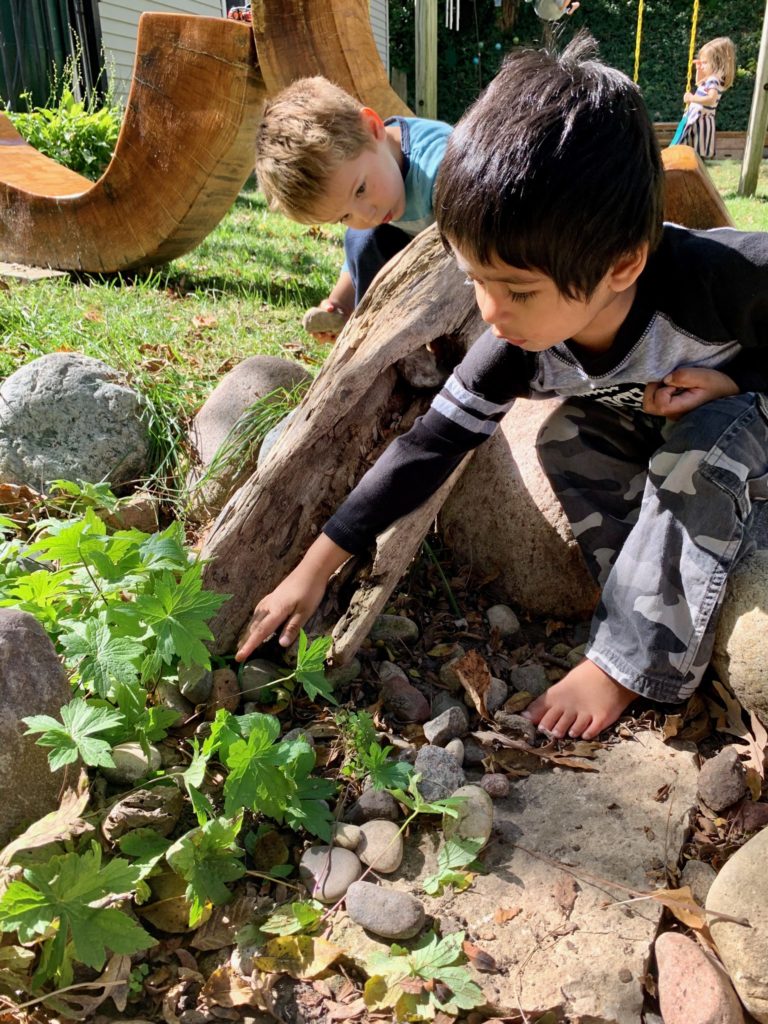
By making predictions, changing designs and collecting data for their next rock, the children are building the foundation for more advanced learning in data analysis and probability in the years to come.
“I think there is something blocking it in there….” Jameson’s voice trails off as he inspects a rock more closely to see why it didn’t tumble in the way that he had expected. He has observed that the rock is encountering some resistance. This is friction!
This is how we lay the foundation of early science through childhood investigation and teamwork. Today, the children are learning about persistence and problem-solving, propelled by the simple but profound joy of creative play.
Now the children are discussing another STEM concept. “Should we flip the log on its other side or move it to a higher rock?” Jameson asks.
I introduce the vocabulary word for their latest STEM adventure: “elevation.”
“Like an elevator! It goes up to the top of the building!” Jameson declares.
I smile. It’s like throwing seeds into the wind. I never know which ones will land on a rock or take root in a little brain. Either way, this is learning through play. Changing the height (elevation) to get a faster roll is working with speed!
The children are also exhibiting a developing sense of spatial awareness as they work out where and in what direction the log should be placed.
“Maybe if we push it, it will go faster!” Sarah suggests.
When you are working on those early learning standards, listen to the words that your students are using. When Sarah uses the word “push,” this is a change that leads to an action. The outcome of that action is an effect!
This is scientific investigation in progress. Words like “push,” “pull,” “launch” and “force” are all science action words.

Ricky—the rock that started this play—is long forgotten. We have naturally moved on to racing our rocks down the tunnel. I am not sure that any child actually remembers which rock is “theirs,” but they know which rock came in first, second, third and last. These are the vocabulary words that tell us that the children are mastering rudimentary skills in numbers and operations. This is a morning of assessment magic!
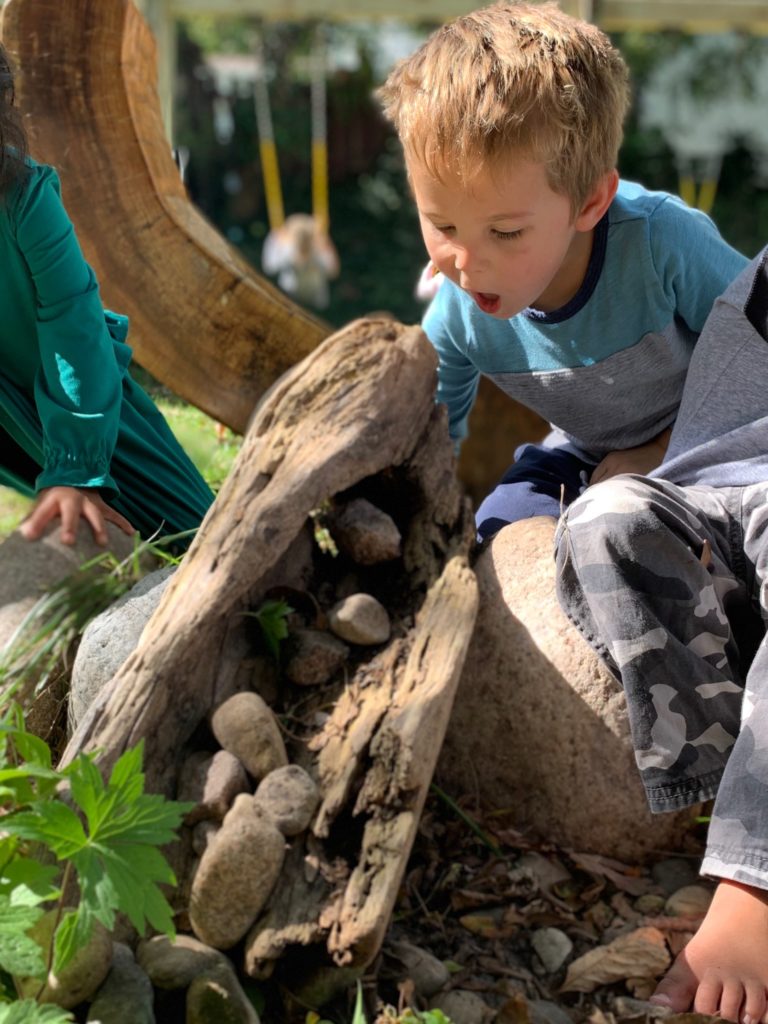
If you have ramps in your classroom, or this is the type of play that sparks your energy, try reading the book, Ricky, the Rock That Couldn’t Roll, aloud to the children. Then place some rocks that roll, along with rocks that don’t roll, in your block area. Observe the investigations that take place and check off some early learning standards of your own!
Happy November, my friends. Stay safe and keep playing!
great observation skills, smat questions navigation from the teacher
Competition is a great motivator- when children are “racing” their rocks it engages their interest and promotes their problem solving skills as to why their rock is not as fast and how to overcome that.
the children in my class love playing with ramps. On our playground, we have some logs and tree stumps that they can use along with rocks to create ramps and explore gravity, friction, speed, etc.
Outdoor observation on a playground or neighborhood walk can be a great assessment tool for math and science.
Rocks and nature are so much fun for young children and older children, too! Lots of great vocabulary words were used as the children have fun manipulating rocks while learning about math and science
Love this! Something that the children discovered on their own! They investigate, observe and use alot of science vocabulary. They also recall the book they have read. Great fun!!
Children can talk about movement, how a rock moves, kick , throw, catch, pass it, roll.
Love this! Thank you!
Through this activity the children have also worked on the cocepts of comparing attributes and classifying. My class did a similar thing by sending small rocks and other objects they found in the playground down our small slide. We had a botttle lid, a rock, a wood chip and a small barrette in our slide race.
Great way for children to learn different forms and areas in which tree stumps, and the movement of the inclines, and different size shapes and weights how they roll. Most definitely a great way to observe, compare, and examine science concepts.
the children can talk the rocks by color, shapes, sizes and if the are heavy or light.
This collection of materials is teaching science, math, social, and emotional skills. Many times it just takes the right teacher giving the children the time to explore. And asking questions at the right times to get them thinking and expanding their vocabulary.
What a fun activity! Can’t wait to read the book.
As an extension, set up different items and a ramp in the classroom to answer the question of which will/will not slide down a ramp. Record discoveries.on a chart.
Use cars and a ramp changing the elevation. Does elevation affect the speed of the car or the distance it travels?
This lesson rocks the children loved it.
This project allowed my children to explore rocks in many different ways and in their natural environment. The children went rock hunting daily.
During our walks they noticed rocks of all shapes, sizes and textures. After they finished collecting they painted their own pet rock.
It’s so important to make and keep things interested.
It’s so important to make and keep things interested to help the children stay engaged.
Loved this activity self created idea by the kids our boys do this all the time with leggos ramps and cars. Buts this was very creative and nature minded. Can’t wait to read the book
Thank you I will use the vocabulary to describe what is happening.
What a perfects science lesson. Asking the right questions is key to get the kids thinking and keeping them on track with the science lesson.
I would add empty paper rolls, and clipboards with crayons for children to draw out their investigations.
This is a great lesson. The children are observing on their own. They are participating in so many different scientific explorations.
I think it is a great lesson that can be incorporated in other areas other than science which is really AWESOME in my eyes.
Wow! What an amazing group of children!! This is a great lesson on so many levels (science, math, language, social). I’m not familiar with Ricky the Rock that Couldn’t Roll. I’ll have to check it out.
This lesson helps children enjoy nature and building things from things they find in nature, thus making walks more interesting.
It not only teaches children about science and math, but they also learn about how much fun you can have with things in nature.
what a great way to learn science. great imagination by the children.
Children have such great imaginations. I tell my 4 yr. olds and my school aged children to never lose their imaginations. If it wasn’t for people’s imaginations and creativity, we wouldn’t have a lot of things today. Using nature as a learning tool is amazing. It opens up so many new ideas for children.
I like the experience the children sre using matters for up and down, roll, sizes, texture, using their imagination.
I like the experience the children sre using matters for up and down, roll, sizes, texture, using their imagination prediction,number and operation,force. It’s good to keep children involved in science a everyday experience of nature.
This name is perfect because sometimes the children are looking for insects and some of them role in their hands. Some don’t want to touch them but sometimes they are curious and touch them by curiosity to feel them.
Children are very curious and they like to explore insects, collect rocks, we raise monarch butterflies in classroom and they collect eggs outside to take them to classroom and home. The parents are asking how to take of them and we are learning together. The are talking about migration too. The name is perfect because the caterpillar dance rock to get out her skin and the chrysalis too during their process to be a butterfly. They don’t roll but fly to migrate.
I think the kids will love learning about science with the rock and roll activity because they are learning the concepts of gravity, up/down and more.
i like how they made a reference to the book that was read prior. And for them to try the different shapes of rocks to see which ones rolled or didn’t
I like how counting and using numbers (Math) is used with science and nature.
I always enjoy when I can provide the children with math concepts as well as science. Good job on this!
There will be many things they will be experimenting with for the first time, and those will be so interesting to them. One of them would be observing how rocks are going down, and they would be excited to place them on the trunk that serves as a slider, also because they are competing.
My children love a great competition! I think they would love to see who’s rock rolls the farthest and the fastest. So many fun ideas that relate to the Rock and Roll book, that it can be never ending!
I love that the children found this activity on their own and the teacher was an observer and built off of what the children were investigating
Natural and physical sciences, the kids made a ramp and compared to a book they had read and then started their own hypothesis. It was great hearing how they did it on their own.
This was very neat tell the kids could understand to prop up a tree log and let rocks roll down it and how far they need to elevate the log to understand the concept of how it works and it’s like science.
Aqui observamos como en la edad temprana de los ninos, que es en el juego donde se perfeccionan las habilidades de resolucion de problemas, y que esto les permitira alcanzar los hitos del aprendizaje temprano. Ellos demuestraron comprension del proceso de clasificacion, comparacion etc.
what a wonderful observation! Cause and effect spatial awareness It has it all!
I love that the children used their imagination and what they recalled from the book to create thier own fun and learning outside. It makes teaching such a joy!!
I love that the children found this activity on their own, and the teacher was an observer and built off of what the children were investigating.
What a wonderful wide range of science concepts
kids are exposed to in this one science activities.
I found this activity be excellent for terms to help
children learn skills impotant to sciience.
I think this is wonderful video, the children are doing a wonderful job, such as exploring doing hands on observation in a physical enhance environment. This also helps in increasing learning skills.
Outdoor activities like this are the best. It allows children to work independently and in groups.
I love how the children are discovering things in their own way and in their own time,
A wonderful yard for the kids to explore, Ponder & figure out why & how.
Experimentation at a child’s level. Being in nature and using nature to learn science.
I love how they are exploring in their own backyard as well as learning different science words and how they work.
When doing this exercise activity with the rocks the children can learn about shape of the rock, gravitational pull, and law of physics. This is when the teacher should implement question to the students to see their prospective of the activity.
Children under my care love rocks, they build ramps with legos and roll rocks and sand on them which teaches them about weight and how it helps roll down the matter through the ramp. It is interesting to hear them play because they say and use scientific words that you didn’t even know they knew!
Great lesson. Children learn so much and by discovering on their own makes it a personal thing that they will always remember.
This is the forts concept Im giving now about the concept children learn from science experiments. For example, when you present them with an object, they are able to use their senses to describe its colors, size, shape and texture.
Love how curious these children are, they made some great observations
Comparing and contrasting different rocks will help the children predict if the rock will roll, stay still or stack. They could also compare rocks to other items such as marbles or buttons.
I love how they were able to make a connection to the book that they previously read, and were able to incorporate it into their own investigation.
I love the book suggestions and what words to listen for to extend a lesson. What I most love is the picture of the kids in your rain garden barefoot and touching the earth with their bare feet.
Hi Julie, I hear the barefoot comment often when I do professional development trainings. Call it “sensory integration.” Write it into your curriculum. We know children learn through their senses.Walking barefoot stimulates the vestibular and proprioceptive senses, which help with balance, coordination, and spatial awareness.Our feet have so many nerve endings and proprioceptors, which send information to the brain about the body’s position. We need to strengthen those bodies to make sitting in a desk or at the table a whole lot easier! Thanks for your kind message and for visiting the Early Science Matters website! Diann
i think that the kids will love learning about rocks with book
The children related to the book about rocks. The named their rocks and watched how each one rolled
This activity will teach kids about nature, shapes, positions and a lot of fun outdoors that can enjoy with friends at school or with family.
This was a very interesting way to teach the kids about nature.
I love the outdoor observations!
Such a great way to encourage wonder and curiosity! I love how you guided them introducing new concepts like elevation to build on what they were already learning
Wonderful lesson to keep kids engaged.
Rocks are almost everywhere I can think back to when I was a kid flat rocks smooth,different shaped big, little and medium sizes the children enjoyed their rocks and the teacher was right their listening, recording and giving them vocabulary.
I liked how the children just started off playing with the rocks in the logs and then discovered how different the rocks were and all rocks wasn’t round and won’t slide like the first rock did.
this lesson allowed the children to express them self and how they use their vocabulary and made up a source of play area using rocks and a tree stump.
I absolutely enjoy your activities. They are so engaging, fun and educational.
Thank you so much for your kind words! We often forget the importance of play and the joy of being a kid!
What fun! I love the interactive play and learning. Awesome job! Definite activity for the Daycare
What fun! I love the interactive play and learning. Awesome job! Definite activity for the Daycare. Thank you
I love how much learning took place with that one activity. the kids aren’t sitting at a table or just listening to a teacher lecture. They are exploring and playing…….exactly how young children learn!
Promoting creativity thinking
Exploring
Enhancing cognitive development
Fun activities
Wow! Can’t wait for school to start & try this!
This project allows children to explore rocks in numerous ways. Great way to get hands and experience
Love how the children are interacting with each other – love how they are so curious and exploring so many ideas in their world. Children’s minds are wonderful!
Children saw and received new sensations and comparisons
Very engaging activity for the children to collect, count, compare and the shape and size of the rocks. Great Math skill and Communication skill
Rock and roll is what they did!
It’s interesting to see how the early math is related to the early science. Kids absorb new terms so easily that then they’re able to communicate them.
I really like this lesson idea! “Painting with the Wind” gives children a fun way to explore nature and learn how the wind moves things. It’s a creative mix of art and early science that encourages curiosity and observation. I also think it’s a great opportunity to build language skills by asking children to describe what they see and how the wind changes their paintings.
I love that this awesome lesson allowed for so many science vocabulary terms. In addition connecting the lessons with children’s literature is wonderful. I am not familiar with Ricky the rock that couldn’t roll, but it looks fun and engaging.
what a great lesson, so many new words that kids can learn.
My kids would love this lesson! Making ramps has been a staple activity in our block area. I would love to bring this thinking outside.
Very helpful for the children! They can learn and develop their vocabulary and curiosity.
I like how they can learn from nature.
This is great because it’s parallel to cars going down a garage ramp which kids love.